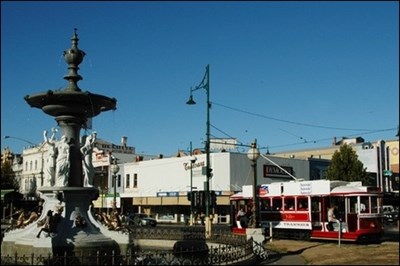Alexandra Fountain EarthCache
-
Difficulty:
-

-
Terrain:
-

Size:  (other)
(other)
Please note Use of geocaching.com services is subject to the terms and conditions
in our disclaimer.
The Alexandra Fountain is arguably the most prominent monument in Bendigo. Located in the centre of Bendigo's Pall Mall the Alexandra Fountain was named after the Princess of Wales, designed by W. C. Vahland. The fountain stands 28ft high from the level of the roadway and its outer basin is 50ft in diameter. The basin itself is 12ft wide from the inner side of the parapet to the plinth of the fountain and contains 2ft of water. The fountain is one of the best known fountains in Victoria. The Alexandra Fountain is close to Rosalind Park, Bendigo's Queen Victoria Statue, The Old Post Office, Law Courts and the central Bendigo shopping Precinct. The fountain was built from the proceeds of the Bendigo Juvenile Industrial Exhibition of 1879, a 500 pound gift from George Lansell the 'Quartz King' of Victoria, George built up an impressive personal fortune from gold mining and speculation during the gold rush era. His home from 1871 - 1935 "Fortuna" is still a showpeice, and 700 pounds from the Sandhurst City Council. The fountain was officially unveiled by His Royal Highness Prince Albert Edward Victor of Wales on 5th July 1881. The fountain is constructed from 20 tonnes of highly polished Harcourt granite and includes dolphins, unicorns, nymphs and allegorical figures. The Alexandra Fountain and Fortuna are just two of the many historical items of interest in and around the city of Bendigo. There are many buildings of note and various historical displays. The Fountain is placed over thousends of quartz reefs under the ground that carry a substance known as gold! How and why is the gold there? How does the gold form? The most common natural method of concentration of gold is through the ancient action of hot fluid inside the Earth's crust. (Fluids deep in the crust are heated by the Earth's internal heat. As they move towards the surface they cool down.) The fluids moved through the rocks over a large area and "dissolved" the gold. When these fluids cooled or reacted with other rocks the dissolved gold precipitated (came out of the fluid) in cracks or fractures forming veins. If the fluids moves over a large enough area, and dissolve the gold for a long enough period of time, gold can be concentrated in amounts in the parts per thousand or even greater. As well as gold, the fluids carried other dissolved minerals, such as quartz. This is why gold is often found with quartz. These are known as primary gold deposits and to extract the gold the rock containing the veins of gold has to be dug up (mined), crushed and processed. In Australia this concentration of gold took place in the Earth hundreds of millions of years ago in the eastern states, and thousands of millions of years ago in Western Australia. The rocks containing the gold veins have now been exposed on the surface and are eroding away. The gold that these rocks contained has been washed down into creeks to form alluvial gold deposits. Here, the gold is further concentrated by the action of water. Because gold is heavier than most of the material moved by a creek or river, it can become concentrated in hollows and trapped in the bed of the river. These are known as secondary gold deposits and they can be worked using a gold pan, cradle.

In order to log this cache you must answer these questions. Please email me with your answers.
1. Who was the stonework by?
2. What naturally occuring stone is the fountain made of (This is a common stone accross the region)
and to prove you visited the site please upload a photo with your log of your GPSr at the fountain.
Additional Hints
(No hints available.)